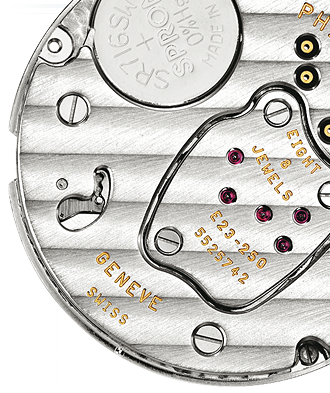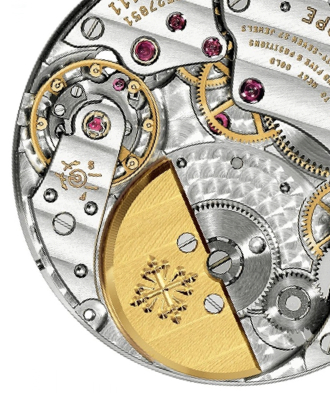Types of Watches Movements
A watch movement (also known as a “calibre”) is the engine of a watch that acts as the powerhouse to make the watch and its functions work. This internal mechanism inside the timepiece moves the hands and powers any complications such as a chronograph,calendar. Driving all of the timekeeping functions, the movement is the essential component in a watch and keeping accurate time; a watch would not function without it.
There are countless different movements that are created by watch manufactures utilizing proprietary innovations, but each of these movements will fall into one of two categories—quartz or mechanical.
MECHANICAL MOVEMENT QUARTZ MOVEMENT
Sweeping motion Individual ticks

An easy way to differentiate a quartz from a mechanical movement is by looking at the second hand. On a quartz watch, the second hand has the tick-tick motion that moves once per second while mechanical watches have a smooth, sweeping seconds motion.
Quartz watches Movement

Quartz movements are very accurate and require minimal maintenance aside from battery replacements. They tend to be low cost since they are battery powered and have few moving parts. Quartz watches aren’t as desirable to most watch enthusiasts because they lack the technical craftsmanship and engineering that mechanical timepieces have.
How a Quartz Movement Works:
A quartz movement utilizes a battery as its primary power source and is typically the type of movement that you will find in your standard, no frills watch. To create power in quartz watch movements, a battery sends an electrical current through a small quartz crystal, electrifying the crystal to create vibrations. These vibrations keep the movement oscillating and drive the motor to move the watch hands.
Mechanical watches Movement

Mechanical movements are often chosen over quartz movements for luxury watches because of the level of quality and craftsmanship of mechanical movements. Skillfully created by expert watchmakers, these movements contain an intricate series of tiny components working together to power the timepiece. Although the general design of mechanical watches hasn’t changed much in centuries, technology has allowed for more precise engineering and a greater attention-to-detail.
How a Mechanical watches Movement Works:
Unlike quartz movements, a mechanical movement uses energy from a wound spring, rather than a battery, to power the watch. This spring stores energy and transfers it through a series of gears and springs, regulating the release of energy to power the watch.
Differences Between Mechanical Movements
There are two types of mechanical movements found in luxury timepieces today, manual and automatic, each with unique characteristics. Although mechanical movements are the preferred movement, the type of mechanical movement comes down to personal preference.
Manual Movement
Considered to be the most traditional movement, manual movements are the oldest type of watch movement. Manual-wind watches that we carry are often loved for their beautiful display of the watch movement, which can usually be seen through the case-back. These movements are often referred to as “hand-wound movements” because they have to be manually wound by hand to create energy in the watch’s mainspring.
How a Manual Movement Works:The wearer must turn the crown multiple times to wind the mainspring and store potential energy. The mainspring will unwind slowly and release energy through a series of gears and springs that regulate the release of energy. This energy is then transferred to turn the watch hands and power the watch’s complications.
Winding Intervals
Winding intervals for manual-wind watches will depend on the power reserve capacity of the movement, which could be 24 hours to five days or more. Some watches will require daily winding, while others have an eight day power reserve, only needs to be wound approximately every eight days. Many manual wind watch owners are simply in the habit of winding their watch before they put it on.

Automatic Movement
The second form of mechanical movements are automatic. Often referred to as “self-winding”, automatic movements harness energy through the natural motion of the wearer’s wrist. Watches with automatic movements are very popular because the wearer doesn’t have to worry about winding the watch daily to ensure constant operation. As long as the watch is worn regularly, it will maintain power without requiring winding.
How an Automatic Movement Works:
An automatic movement works largely the same way that manual movements do, with the addition of a metal weight called a rotor. The rotor is connected to the movement and it can rotate freely. With each movement of the wrist, the rotor spins, transferring energy and automatically winding the mainspring.
Winding Intervals
Watches featuring an automatic movement will still require winding, but dramatically less than a manual watch. If the watch is worn every day, it will maintain timekeeping functions without winding; but if the watch hasn’t been worn for an extended period of time, it will need a quick wind to garner initial power. A great alternative to hand winding automatic watches is to use a watch winder, which will keep the watch fully wound when it’s not being worn.



